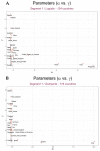Which National Factors Are Most Influential in the Spread of COVID-19?
- PMID: 34300044
- PMCID: PMC8307075
- DOI: 10.3390/ijerph18147592
Which National Factors Are Most Influential in the Spread of COVID-19?
Abstract
The outbreak of the novel COVID-19, declared a global pandemic by WHO, is the most serious public health threat seen in terms of respiratory viruses since the 1918 H1N1 influenza pandemic. It is surprising that the total number of COVID-19 confirmed cases and the number of deaths has varied greatly across countries. Such great variations are caused by age population, health conditions, travel, economy, and environmental factors. Here, we investigated which national factors (life expectancy, aging index, human development index, percentage of malnourished people in the population, extreme poverty, economic ability, health policy, population, age distributions, etc.) influenced the spread of COVID-19 through systematic statistical analysis. First, we employed segmented growth curve models (GCMs) to model the cumulative confirmed cases for 134 countries from 1 January to 31 August 2020 (logistic and Gompertz). Thus, each country's COVID-19 spread pattern was summarized into three growth-curve model parameters. Secondly, we investigated the relationship of selected 31 national factors (from KOSIS and Our World in Data) to these GCM parameters. Our analysis showed that with time, the parameters were influenced by different factors; for example, the parameter related to the maximum number of predicted cumulative confirmed cases was greatly influenced by the total population size, as expected. The other parameter related to the rate of spread of COVID-19 was influenced by aging index, cardiovascular death rate, extreme poverty, median age, percentage of population aged 65 or 70 and older, and so forth. We hope that with their consideration of a country's resources and population dynamics that our results will help in making informed decisions with the most impact against similar infectious diseases.
Keywords: COVID-19; SARS-CoV-2; growth curve models; pandemic.
Conflict of interest statement
The authors declare no conflict of interest.
Figures










Similar articles
-
Travel-related control measures to contain the COVID-19 pandemic: a rapid review.Cochrane Database Syst Rev. 2020 Oct 5;10:CD013717. doi: 10.1002/14651858.CD013717. Cochrane Database Syst Rev. 2020. Update in: Cochrane Database Syst Rev. 2021 Mar 25;3:CD013717. doi: 10.1002/14651858.CD013717.pub2. PMID: 33502002 Updated.
-
Modeling and tracking Covid-19 cases using Big Data analytics on HPCC system platformm.J Big Data. 2021;8(1):33. doi: 10.1186/s40537-021-00423-z. Epub 2021 Feb 15. J Big Data. 2021. PMID: 33614394 Free PMC article.
-
Assessing COVID-19 pandemic policies and behaviours and their economic and educational trade-offs across US states from Jan 1, 2020, to July 31, 2022: an observational analysis.Lancet. 2023 Apr 22;401(10385):1341-1360. doi: 10.1016/S0140-6736(23)00461-0. Epub 2023 Mar 23. Lancet. 2023. PMID: 36966780 Free PMC article.
-
International travel-related control measures to contain the COVID-19 pandemic: a rapid review.Cochrane Database Syst Rev. 2021 Mar 25;3(3):CD013717. doi: 10.1002/14651858.CD013717.pub2. Cochrane Database Syst Rev. 2021. PMID: 33763851 Free PMC article.
-
Estimation of exponential growth rate and basic reproduction number of the coronavirus disease 2019 (COVID-19) in Africa.Infect Dis Poverty. 2020 Jul 16;9(1):96. doi: 10.1186/s40249-020-00718-y. Infect Dis Poverty. 2020. PMID: 32678037 Free PMC article.
Cited by
-
Nonlinear time series analysis of state-wise COVID-19 in Malaysia using wavelet and persistent homology.Sci Rep. 2024 Nov 11;14(1):27562. doi: 10.1038/s41598-024-79002-0. Sci Rep. 2024. PMID: 39528569 Free PMC article.
-
Effects of government policies on the spread of COVID-19 worldwide.Sci Rep. 2021 Oct 14;11(1):20495. doi: 10.1038/s41598-021-99368-9. Sci Rep. 2021. PMID: 34650119 Free PMC article.
-
The Influence of Metabolic Syndrome on the Development of Gastrointestinal Malignant Tumors-A Review.Medicina (Kaunas). 2025 May 31;61(6):1025. doi: 10.3390/medicina61061025. Medicina (Kaunas). 2025. PMID: 40572713 Free PMC article. Review.
-
Effectiveness of controlling COVID-19 epidemic by implementing soft lockdown policy and extensive community screening in Taiwan.Sci Rep. 2022 Jul 14;12(1):12053. doi: 10.1038/s41598-022-16011-x. Sci Rep. 2022. PMID: 35835796 Free PMC article.
References
-
- Priyadarsini S.L., Suresh M. Factors influencing the epidemiological characteristics of pandemic COVID 19: A TISM approach. Int. J. Healthc. Manag. 2020;13:89–98. doi: 10.1080/20479700.2020.1755804. - DOI
-
- WHO Director-General’s Opening Remarks. [(accessed on 8 February 2021)]; Available online: https://www.who.int/dg/speeches/detail/whComingsoono-director-general-s-....
-
- Worldometer. [(accessed on 8 February 2021)]; Available online: https://www.worldometers.info/coronavirus/
Publication types
MeSH terms
Grants and funding
LinkOut - more resources
Full Text Sources
Medical
Miscellaneous

